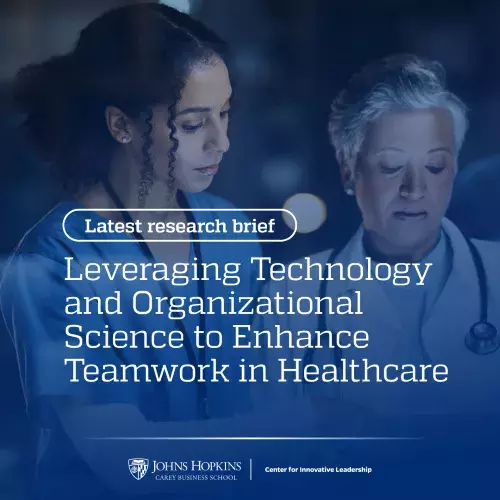By integrating new technologies and insights from organizational science health care, leaders can embrace the digital era in ways that positively impact team design and teaming practices.

Leveraging Technology and Organizational Science to Enhance Teamwork in Health Care
Summary
As in many sectors, leaders in healthcare settings are having to find new ways of teaming that take account of today’s more mobile workforces, dispersed communications, integration of digital systems, and the increasing complexity of work. In this new working environment, conventional team design—which relies on stability and long-term relationship-building to enable process development and observational learning—no longer applies. To date, in healthcare, little effort has gone into finding solutions that fit the current reality of modern team design, and this has been shown to significantly degrade patient outcomes.
While decades of academic research have focused on teamwork more broadly, a recent article calls for insights from research in the organizational sciences and related fields to inform technology development by healthcare professionals to cultivate more robust ways of working together.
The reliable stability of healthcare teams of the past is no longer with us. Today, in an environment characterized by high turnover and labor shortages, healthcare facilities employ more temporary and mobile workforces than ever. Teams also tend to be larger, including clinicians with diverse and specialized expertise, due to patients’ increasingly complex needs. Individual clinicians will often have roles in several different care teams, and the typical healthcare team—evolving and reconfiguring with new members all the time—will often have no history of collaboration. Consequently, team boundaries tend to be blurred and communications fragmented, resulting in sub-optimal team performance and patient outcomes.
Digital technology has been proposed as a solution. However, while messaging apps and electronic medical record systems are clearly valuable and have the potential to ensure care team members are in the loop, they are far from a panacea. Increasing the number of options for asynchronous communication can give providers a false sense that they no longer need to have the “real-time” conversations that are necessary for complex decision making in many cases. And increasing the number of options for communication without addressing the human needs for clear norms about when, how, and what to communicate–and a clear understanding of who should be “in” the team at any moment–can risk further fragmenting a team while overloading some and excluding critical input from others who, despite having myriad ways of digitally connecting, remain out of sight, out of mind.
The shift towards reliance on digital technologies can also stymie opportunities for vicarious learning—learning from the experience of others; a conscious process that involves directly sensing, empathizing with, reflecting on, and evaluating what other people are doing. A stark example of what has been lost comes with the use of robots in surgery. That only two hands are needed to operate a robotic tool during surgery, compared to the many hands involved in more traditional surgical approaches, has consequently limited opportunities for trainees to learn by working with experienced senior colleagues.
A recent article in the New England Journal of Medicine from a team including Anna Mayo and Christopher Myers, faculty members of the Center for Innovative Leadership at Johns Hopkins Carey Business School, highlights that in relying on technology to resolve what is essentially a failure of team practices to move with the times, there is a risk in deploying that technology without an appreciation of the human processes that are fundamental to effective coordination and learning. It calls for healthcare researchers, developers, and practitioners to integrate new technology development efforts with insights from research in organizational science and related fields, including studies undertaken in healthcare settings, in order to better support smart teamwork practices that are fit for the modern healthcare workplace.
The opportunity of better integrated technologies
As well as posing challenges, digital technologies of course carry great opportunity for healthcare teaming too—which can be unlocked with more thoughtful integration. A deeper understanding of the human constraints on teamwork in healthcare can help guide more effective technology-based interventions to track and increase coordination and learning.
As teams have become more complex and dynamic, there is a rise in attention-management challenges for providers–who need to know not just what to communicate but also and how, when, where, and to whom. If a new communication technology is introduced, it would likely benefit all those affected to have clear expectations for how that platform will be used (e.g., updates vs urgent matters vs non-urgent questions; coordination vs decision making, etc.). At the same time, these tools could be designed to encourage collaboration and support attention management—perhaps, for example, using AI to highlight instances when a role’s input is likely missing, or when a provider is becoming overloaded with messages. AI tools have tremendous potential to enhance the coordination of inputs in modern teams—bearing in mind the usual caveats, that any potential lack of transparency, perpetuated bias, or data security risk can create distrust.
At the same time, new team forms and the increased adoption of technologies are limiting the opportunities for informal learning that have been essential to the maintenance and growth an effective workforce. Given this environment, recent findings from organizational science—for instance on the power of creating spaces for informal conversation and knowledge sharing—can shed light on both the importance of continuing to invest in physical spaces as well as the potential for virtual spaces that could enable the same kind of collective reflection and processing.
As these examples illustrate, integrating findings from organization science with technology development could point to powerful levers to support robust teamwork, which in turn will not only improve the care of current patients, but will increase opportunities for learning from others, which is a critical component of teamwork in healthcare and is necessary for improving care for future patients.


